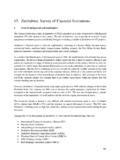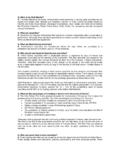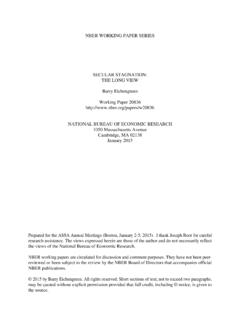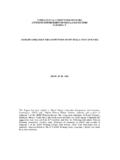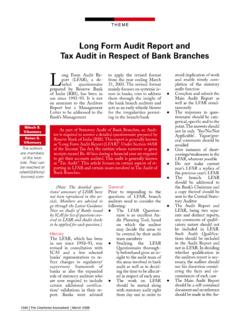Transcription of THE ROLE OF BANKS, EQUITY MARKETS AND …
1 THE ROLE OF BANKS, EQUITY MARKETS AND institutional INVESTORS IN long -TERM FINANCING FOR GROWTH AND DEVELOPMENT Report for G20 Leaders February 2013 This report was presented at the Meeting of the G20 Finance Ministers and Central Banks Governors on 15-16 February 2013 in Moscow. At this meeting G20 leaders agreed to establish a Study Group on Financing for Investment with the co-operation of international organizations. The findings of this report will contribute to the work of the Study Group.
2 THE ROLE OF BANKS, EQUITY MARKETS AND institutional INVESTORS IN long -TERM FINANCING FOR GROWTH AND DEVELOPMENT is available online at This document and any map included herein are without prejudice to the status of or sovereignty over any territory, to the delimitation of international frontiers and boundaries and to the name of any territory, city or area. Ce document et toute carte qu'il peut comprendre ne pr jugent en rien du statut de tout territoire, de la souverainet s exer ant sur ce dernier, du trac des fronti res et limites internationales, et du nom de tout territoire, ville ou r gion.
3 OECD 2013 Applications for permission to reproduce or translate all or part of this material should be made to: OECD Publishing, or by fax: +33 1 45 24 99 30. Table of Contents 1. INTRODUCTION .. 4 2. bank BUSINESS MODELS, LENDING AND long -TERM INVESTMENT .. 6 3. EQUITY MARKETS , CORPORATE GOVERNANCE AND long -TERM FINANCING .. 12 4. THE ROLE OF institutional INVESTORS IN long -TERM FINANCING .. 15 5. INFRASTRUCTURE INVESTMENT .. 24 6. 37 APPENDIX 1. SME FINANCING .. 38 APPENDIX 2. PENSION FUNDS AND INSURERS TO GDP RATIOS.
4 40 APPENDIX 3. CLEAN ENERGY ASSET FINANCING .. 41 4 Role of Banks, EQUITY MARKETS and institutional Investors in long -Term Financing for Growth and Development - OECD 2013 1. INTRODUCTION The financial sector plays an essential role in providing and channeling financing for investment. Beyond providing short-term finance for businesses' day-to-day operations and other temporary cash requirements, financial institutions, capital MARKETS and institutional investors are also sources of long -term finance that is finance which is available for an extended period of time1.
5 The importance of long -term finance lies in its pivotal role in satisfying long -term physical investment needs across all sectors in the economy and specifically in key drivers of growth, competitiveness and employment such as the infrastructure, real estate, R&D and new ventures. Traditionally, banks have been a key player in the financial system, transforming savings into long -term capital to finance private sector investment. Over time, two main changes have taken place in the structure of the financial system.
6 First, the banking model has evolved, becoming increasingly dominated by wholesale MARKETS and in particular derivatives, to the detriment of the more traditional deposit-taking and lending activities. Second, disintermediation and the growth of capital MARKETS has led to a shift in the structure of the financial sector, with institutional investors such as pension funds, insurance companies, mutual funds, and, most recently, sovereign wealth funds, also becoming central players as providers of long -term capital.
7 After the financial crisis, the traditional sources of investment financing are all facing challenges whether it be fiscal constraints on government spending, or the weak economic outlook not proving conducive to corporate investment (with implications for both the debt and EQUITY MARKETS ), with the main blockages to investment remaining in the banking sector. Structural weaknesses in the banking sector are leading to bad deleveraging, particularly in Europe, in the form of restrained credit growth.
8 This is causing a growing mismatch between the amount and time horizon of available capital and the demand for long -term finance. New banking regulations (Basle III) could also affect negatively the ability of banks to provide long -term financing. The emerging long -term financing gap is particularly acute in the infrastructure sector and could slow down the world economy for years to come and abort attempts by emerging and developing economies (EMDEs) to set themselves on a high-growth path.
9 With over USD 70 trillion in assets, institutional investors (such as pension funds and insurance companies) are frequently cited as an alternative source of financing. Given the low interest rate environment and volatile stock MARKETS of recent years, institutional investors are increasingly looking for new sources of long -term, inflation protected returns. Investments in real, productive assets, such as infrastructure could potentially provide the type of income which these investors require supporting investment and driving growth.
10 However, there are also major challenges to higher allocations to such assets, from the small size of many pension funds and insurers to regulatory barriers. 1 For the purposes of the G20 note, long -term has been defined as maturities of at least five years. It also refers to sources of financing that have no specific maturity but are generally relatively stable over time. The OECD has recently launched a project on long Term Investment ( ), identifying a set of criteria for long -term investment by institutional investors: productive capital, providing support for infrastructure development, green growth initiatives, SME finance etc.










